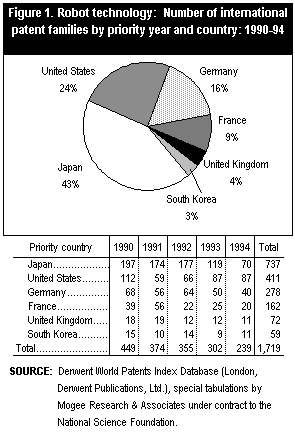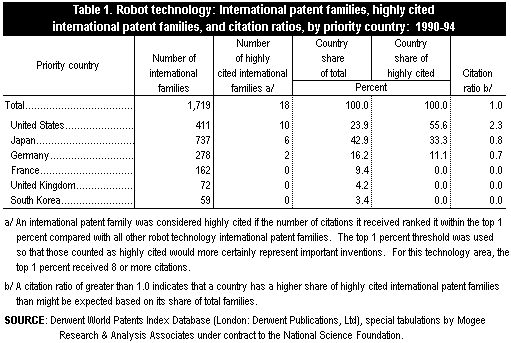
Directorate for Social, Behavioral
and Economic Sciences
NSF 99-343 April 22, 1999
Manufacturing Technologies: Robots

Over the five-year period 1990-94, Japan ranks number one in robot technology patent activity.
The United States had the most highly cited robot inventions of the six nations examined.
This report is the first in a three-part series that examines America’s technological position vis-à-vis that of five other countries—Japan, Germany, France, the United Kingdom, and South Korea—in high-tech areas likely to be important to future economic competitiveness. The areas examined are advanced manufacturing, biotechnology, and advanced materials; the indicator used to determine a country’s relative strength and interest in these areas is international patent activity. To facilitate patent search and analysis, the three broad areas are each represented by a narrower subfield. This report examines robot technologies as a proxy for advanced manufacturing technologies.[1]
As used here, robot technology covers program-controlled manipulators—e.g., the manipulator, program control, gripping heads, joints, arm sensors, safety devices, and accessories—and excludes non-program-controlled manipulators, prosthetic devices, and toy robots.
The analysis is built around the concept of a patent family which consists of all the patent documents published in different countries associated with a single invention. The first application filed anywhere in the world is the priority application: it is assumed that the country in which the priority application was filed is the country in which the invention was developed. Similarly, the priority year is the year the priority application was filed. The basic patent is the first patent or patent application published in any of the roughly 40 countries covered in the database used (the Derwent World Patents Index Latest).
International patent families are used to mitigate bias introduced by national systems, such as Japan’s, that encourage large numbers of domestic patent applications. An international patent family is created when patent protection is sought in at least one other country besides that in which the earliest priority application was filed.
The three indicators used in this assessment are overall trends in international inventive (patenting) activity, highly cited inventions, and the size of international patent families.
International Patenting Activity
Tabulated by priority year, this indicator provides a first measure of the extent and growth of each nation’s inventive activity. These patent family counts represent inventions important enough to be patented outside of the country of origin. During the first half of the 1990s, 1,719 international patent families were formed in robotics with priority applications in the six countries examined (figure 1). Patenting activity in this six-country group accounts for about three-quarters of all families in this technology area.

The conventional perception of Japan as an innovator in the area of advanced manufacturing techniques is reinforced by the large number of robotic inventions originating there. Japan led all other countries studied in the total number of international patent families in robot technology created during the 1990-94 period. Japanese inventors held 43 percent of the total number of international patent families formed by the six countries included in the study, followed by the United States (24 percent), Germany (16 percent), France (9 percent), the United Kingdom (4 percent) and South Korea (3 percent).
Over the five-year period 1990-94, Japan ranks number one in robot technology patent activity; however, this activity dropped dramatically after 1992. At about the same time, U.S. activity picked up: in 1994, the United States led Japan in the number of international robot technology patent families formed.
Although South Korea’s share of international patent families was the lowest overall, its share approached that of the larger and more advanced economy of the United Kingdom. Given its newly industrialized economy status, South Korea’s over-all international inventive activity in this technology area is noteworthy—especially when the data show that South Korea’s robot technology patenting activity equaled that of the United Kingdom in 1994.
Highly Cited Robot Inventions
Interpatent citations are an accepted method of gauging the technological value or significance of different patents. These citations, provided by the patent examiner, indicate the “prior art”—the technology in related fields of invention taken into account in judging the novelty of the present invention. The number of citations a patent receives from later patents can serve as an indicator of its technical importance or value. In fact, Carpenter, Narin, and Woolf (1981) have shown that, on average, technologically important U.S. patents receive twice as many examiner citations as does the average U.S. patent, reinforcing the validity of interpatent citation as an indicator of patent quality.
The United States led the group with 55.6 percent of all highly cited robot technology international families generated during the 1990-94 period (10 of 18).[2] Japan, with 33.3 percent of the highly cited patents, and Germany, with 11.1 percent, trailed distantly (table 1). The United Kingdom, France, and South Korea did not have any international robot families in the highly cited group.

Only the United States had more highly cited international patent families than might be expected—2.3 times—based on its level of activity (that is, the total number of U.S. international robot technology families). Specifically, Japan produced only 80 percent of what might be expected based on the number of inventions it produced during this period, and Germany produced only 70 percent of what might be expected. Again, France, the United Kingdom, and South Korea—with nearly 300 international robot patent families among them—had no highly cited robot inventions during this period.
The United States thus appears to have contributed a disproportionate number of important robot inventions relative to its level of inventive activity.
Average International Patent Family Size
Given the significant costs associated with obtaining patent protection in multiple countries, this indicator attempts to measure the perceived economic potential of a robot invention by calculating the number of countries in which patent protection is being sought, adjusted for market size.[3] When average international patent family size is calculated for each country’s robot technologies, there is not as much separation in the scores as might be expected (table 2). U.S. inventions received the highest score and therefore have the highest level of perceived commercial value based on this measure. South Korean inventions received the lowest score. Since most inventions are first patented in the country in which the inventor resides, U.S. inventions have an advantage in this indicator due to the large size of the U.S. economy.[4] But European inventions also have the advantage of many commercial, locational, and historical ties that facilitate multiple-country patenting. Furthermore, the move toward European unification has encouraged wider patenting within Europe. U.S. inventions nonetheless scored slightly higher on average than did European robot inventions. Japan’s robot inventions also scored well on this indicator, bolstered by the tendency of Japanese inventors to seek patent protection in large economies such as the United States and Germany (79 and 60 percent, respectively). South Korea scored high, but it too sought patent protection for most of its robot inventions in large markets like the United States (64 percent) and Japan (41 percent).

Summary of U.S. Position
Based on this examination of international patenting in robot technologies during 1990-94, the U.S. science and technology enterprise emerges as an important producer of inventions in this key technology area, whose inventions are patent protected throughout the world. Over the five-year period examined, the number of U.S. robotic inventions patented in more than one country was second only to Japan’s. By 1994, the United States surpassed Japan in the number of international patent families formed. U.S. robot inventions appear to be important: they were cited by later patents far more often than those originating in any of the other five countries studied. Finally, U.S. robot inventions have the highest perceived economic value as measured by average international patent family size among those of the five countries; however, the large size of the U.S. economy provides a considerable advantage in this calculation.
References
Carpenter, M.P., F. Narin, and P. Woolf. 1981. “Citation Rates to Technologically Important Patents.” World Patent Information 1981: 160-63.
Claus, P., and P.A. Higham. 1982. “Study of Citations Given in Search Reports of International Patent Applications Published Under the Patent Cooperation Treaty.” World Patent Information 4: 105-9.
Mogee Research & Analysis Associates. 1997. Comparing Assessments of National Position in Key Science & Technology Fields. Report prepared under National Science Foundation SGER Grant No. SRS-9618668. Washington, DC.
Narin, F., K. Hamilton, and D. Olivastro. 1997. “The Increasing Linkage Between U.S. Technology and Public Science.” Research Policy 26, No. 3 (December): 317-30.
National Critical Technologies Review Group. March 1995. National Critical Technologies Report. Washington, DC.
Office of Science and Technology Policy (OSTP). 1995. National Critical Technologies Report. Washington, DC: National Critical Technologies Panel.
———. 1997. Science & Technology Shaping the Twenty-First Century. Washington, DC: Executive Office of the President.
Popper, S., C. Wagner, and E. Larson. 1998. New Forces at Work: Industry Views Critical Technologies. Santa Monica, CA: RAND.
This Issue Brief was prepared by:
Lawrence M. Rausch
Division of Science Resources Studies
National Science Foundation
4201 Wilson Boulevard, Suite 965
Arlington, VA 22230
703-306-1777 ext. 6927
E-mail: lrausch@nsf.gov
SRS data are available through the World Wide Web (http://www.nsf.gov/sbe/srs/stats.htm). For more information about obtaining reports, contact pubs@nsf.gov. or call (301) 947-2722. For NSF's Telephonic Device for the Deaf, dial (703) 306-0090. In your request, include the NSF publication number and title, your name, and a complete mailing address.